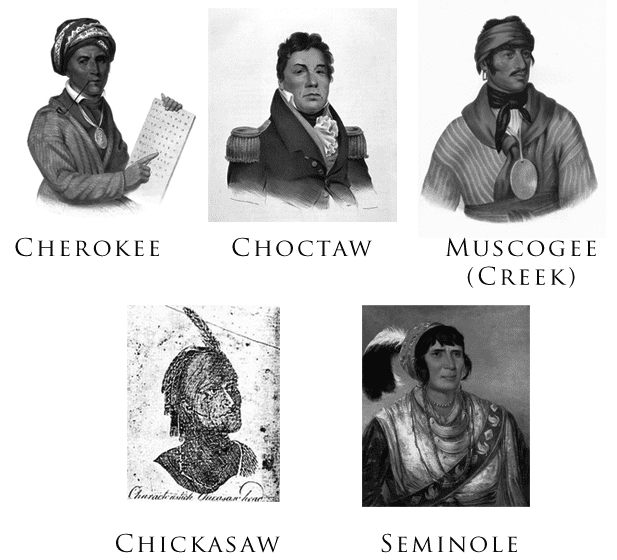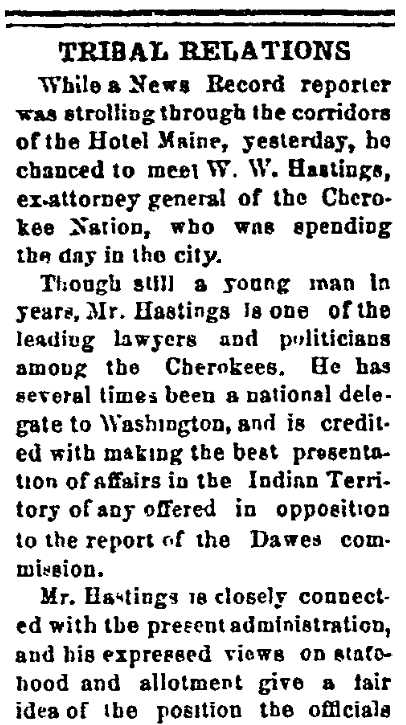Introduction: In this article – to help celebrate National Native American Heritage Month – Gena Philibert-Ortega explains how to use the Dawes Rolls for your Native American genealogy. Gena is a genealogist and author of the book “From the Family Kitchen.”
“My grandmother was a Cherokee Indian!” Many researchers start their genealogy journey because they’ve heard a family story of Native American roots. In many cases this might just simply be a family legend – but in others, the paper trail may confirm that story. For those with Cherokee, Creek, Choctaw, Chickasaw, and Seminole ancestry (known as the “Five Civilized Tribes”), one resource to use is the Dawes Rolls.

The Dawes Commission
What are the Dawes Rolls? President Grover Cleveland in 1893 appointed The Commission to the Five Civilized Tribes, also known as the Dawes Commission after its chairman Henry L. Dawes. This commission was to negotiate land with the Cherokee, Creek, Choctaw, Chickasaw, and Seminole tribes. The purpose of the commission’s work was to abolish tribal, communally-owned lands, and break these large areas into individual allotments for each member of the tribe – with the “surplus” land sold off to white settlers.

In order to receive land allotments, individual members of each tribe had to be deemed eligible for tribal membership. The Commission started the enrollment process in 1896 but that effort was deemed invalid, and they began again in 1898 which meant that anyone who had applied in 1896 had to re-apply. The Commission took applications until 1907; however, there were some additional individuals added up to 1914. (1)
What Are the Dawes Rolls?
The more than 101,000 names found on these “Final Rolls” are of those people eligible for tribal membership in the Cherokee, Creek, Choctaw, Chickasaw, or Seminole tribes. Information included in these records are: name, blood degree, and genealogical descent, and you may find supporting documentation including correspondence and vital records. The records available include enrollment cards, applications for enrollment, and letter logs. (2) Those who were eligible for tribal membership were entitled to land. The Rolls span the years 1898-1914.
What you will not find in the Dawes Rolls are “those applications that were stricken, rejected or judged as doubtful,” but it does include those who were not approved. (3,4) This is important because not everyone who was part of those five tribes is found on these Rolls for various reasons. Over 250,000 people applied but only 101,000 were approved. (5)

Also, if your ancestor was a member of one of the five tribes but did not live in Oklahoma Territory, they are unlikely to be found on the Rolls since there was a residency requirement. If you’re not sure where your ancestor was during the enrollment, you can search the 1900 U.S. Federal Census or the 1900 U.S. Indian Census Rolls to determine if your ancestor was living in the Oklahoma Territory during this time.
One last point. If your great-grandmother was Cherokee but deceased by the time of the enrollment, check for the names of her descendants who were living in Oklahoma Territory and may have enrolled.
For More Information
- To learn more about searching the Dawes Rolls and where they can be found online, see the FamilySearch Research Wiki article Dawes Commission Enrollment Records.
- The National Archives holdings include the Dawes Rolls, and their website has an article with information about the Rolls and how to search them.
- A free index to the Rolls can be found at the Oklahoma Historical Society website.
- Another free index to the Rolls is at the Access Genealogy website.
- GenealogyBank has a Native American newspaper collection that also might be of interest to you. The collection includes the Cherokee Advocate.
Be aware that if your purpose for your genealogical research is to prove your Native American ancestry, you will need to consult the tribe’s website for information about what is required for possible membership. More may be required than simply finding an ancestor listed on the Dawes Rolls.
_______________
(1) “Dawes Rolls,” National Archives (https://www.archives.gov/research/native-americans/dawes/tutorial/intro.html: accessed 21 November 2019).
(2) “Dawes Commission Enrollment Records,” FamilySearch Research Wiki (https://www.familysearch.org/wiki/en/Dawes_Commission_Enrollment_Records: accessed 21 November 2019).
(3) “Dawes Rolls,” National Archives (https://www.archives.gov/research/native-americans/dawes/tutorial/intro.html: accessed 21 November 2019).
(4) “Dawes Commission Enrollment Records,” FamilySearch Research Wiki (https://www.familysearch.org/wiki/en/Dawes_Commission_Enrollment_Records: accessed 21 November 2019).
(5) Ibid.
Related Articles:
- Native American Genealogy: Research Tips & Resources
- Three Steps to Beginning Your Native American Genealogy Research
- Cherokee Phoenix, the First Native American Newspaper

Why are there so many controversial depictions of Indigenous Americans and white-looking Native Americans? Why do books from authors like Alvin M. Joseph Jr., Hugh Hopkins, Forbes, Thomas Ward, Don Francisco Fernandez, William Waller Hening, Thomas L. McKenney, William Clint, Robert Knox, and George Carlin do this? These are accredited authors of prestigious universities, with either first-hand accounts of peoples of America or they interviewed someone with first-hand accounts. There are more but these are ones I chose to emphasize.
This has to jog one’s curiosity. This is not all because someone was lazy or tried to categorizing a people. They actually recorded what they saw. This alone makes it justifiable.
Thank you so much for taking the time to comment. I appreciate it.
Thank you so much for helping me understand the path that I must take in order to trace descendants of my Native American heritage. Thank you very much!
Thank you Lisa for your kind comment. Good luck with your research!–Gena
I’m trying to regain all stolen information and identity of not only myself, but my family and ancestors. I was approximately age 4 when we left Arizona. All information was stored in a safe which has been stolen in the state of Illinois, Wabash County, city of Mount Carmel. The police and courts refuse to arrest, charge and convict.
Thank you.
Tina M. Berry
I’m sorry to hear that Tina. You could write to your birth state to get duplicate copies of your birth certificate or the date state for family members to order death certificates.
Good luck in your search.
I am searching for information on what tribe my ancestor, Mae Fild Shields Buchanan, came from. Her husband was Seth Eugene Buchanan. My grandfather’s grandmother was Eva Viola Cooper. I do not know the tribe/s that I come from — that is why I am doing the research, so I know for sure what tribe/s are in my timeline. Any idea how I should go about this?
Raymond, you don’t mention the place or the time period but if we are talking the later 19th century or 20th century, I’d start with the census and then go from there. You might want to read through these wiki pages on the FamilySearch Research Wiki, https://www.familysearch.org/wiki/en/Indigenous_Peoples_of_the_United_States_Genealogy .
I am looking for a Dawes Roll # with my mom’s name, Irene Sweeney, on it. I have my great aunt Dona Reed’s Dawes Roll # — she was Choctaw by blood. Thanks for your help.
I am wanting to find a way to search the Dawes Rolls from my laptop at my apartment. Any ideas? Thanks.
Is there anything similar to the Dawes Roll for Natives Americans living within Alabama, Kentucky, Arkansas or Tennessee? I’m having trouble finding anything to confirm what tribe my ancestors came from. Any thoughts?
I found my great great grandmother’s name on this Campbell’s extract but I don’t see a card for her.
Her name is Belcher, Sila. She had the number 29 by her name; what does that mean?
My father passed when I was 4. I never knew his side of the family. His mother was a Thorp/Thorpe. I was named after her. I can find her on the census but they have her using two different names. From what I was told he was somehow related to Jim Thorpe but I don’t know the truth. I was told my grandmother (his mom) had asked all the kids if they wanted to file their Indian rights. They all said no, they were not Indian. My dad was too young to say anything and without knowing anything about his family I’m totally lost. Guess I might need to find someone who does this to do it for me, depending on the cost.
My maternal great grandmother and my paternal grandmother both have said that I am of Cherokee descent, the tribe from the North Carolina region. I am more than interested to find out. I’d love to know my ancestry. I just don’t know how to find out exactly!
How do I find information about my daddy’s tribal membership? He lived in Greenville, South Carolina. His name is Luther Rainey, and I was told he was Cherokee. Thanks.